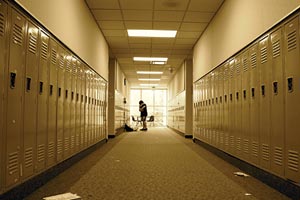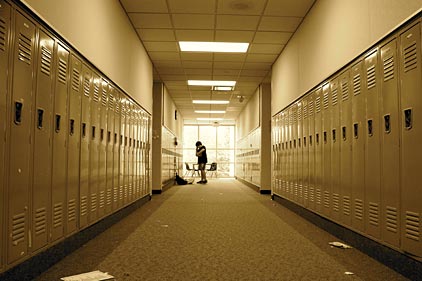
|
| (Photo by Daniel X. O'Neil) |
In the U.S., public schools are being constructed with energy efficiency and resource conservation in mind more than ever before. On the extreme end, net-zero schools are installing solar panels, ultra-efficient insulation, and high-efficiency HVAC systems to produce at least as much energy as they use. When building new facilities, school officials are expressing a concerted interest in reducing their carbon footprints, conserving finite resources, and providing a healthy and comfortable environment for students, teachers, and staff.
But what about the roughly 99,000 public schools that already exist in the U.S.?
According to the U.S. Green Building Council (USGBC) Center for Green Schools, a great many of them are falling by the wayside. In fact, according to the center’s first State of Our Schools report, it would take roughly $271 billion to bring public school buildings across the U.S. up to working order to gain compliance with the law, and a staggering $542 billion to meet current health, safety, and education standards.
State of Our Schools
The 2013 State of Our Schools report includes a foreword from former President Bill Clinton and a letter to Congress signed by numerous organizations, including ASHRAE, asking for an updated Government Accountability Office (GAO) study on the condition of America’s school facilities (the last survey was done in 1995). The information, according to the Center for Green Schools, would then be used to understand the current state of school buildings — including the HVAC systems — across the U.S. and allow districts to more effectively direct their limited funds to where they are most needed in order to improve student comfort, health, safety, and performance.
“Peer-reviewed research demonstrates that the quality of educational facilities can affect health, learning, and attendance,” said William Bahnfleth, ASHRAE president. “High-performance school buildings provide conditions for learning demonstrated to have a positive impact through appropriate lighting, acoustics, temperature and humidity control, and IAQ. Poor control of the indoor environment contributes to incidents of asthma attacks and other health problems that contribute to absenteeism and degraded performance.”
Rachel Gutter, director of the Center for Green Schools, said bringing the HVAC systems in schools up to date will be a key part of improving student health and performance.
“A lot of these systems are coming to an age when they need to be replaced, and when they’re replaced, they’ll be replaced with modernized energy-efficient systems that are the right size,” she said. “When we look at the $271 billion deferred maintenance gap, a lot of the money that will need to be expended will need to be invested in major systems, like the HVAC systems. Even those that are functioning are significantly outdated and are probably not correctly sized or energy efficient.”
“According to the Center for Green Schools, 40 percent of school nurses report that students and staff are adversely affected by IAQ problems,” Bahnfleth added.
Chris Tyler, board chair, USGBC Kentucky chapter, said the report emphasizes the dire need for more detailed information about the country’s school buildings in order to develop an effective plan of action at the local level.
“We do have a lot of schools that are cutting edge, like the net-zero schools, and that’s one extreme case,” he said. “But on the flip side, we have a lot of schools and a lot of needs in our nation as a whole that really need to be met.”
What Contractors Can Do
In addition to emphasizing the need for current data on school buildings, the USGBC and Architecture for Humanity go a step further to outline what school staff, parents, community members, and HVAC professionals can do to begin improving their community’s schools through its Green Schools Investment Guide. The document includes information on how to identify issues within the school, how to approach school administrators about those issues, and even how to fund those much-needed improvements.
“I think it’s really important for folks who are working in the HVAC industry to help school facilities staff and other school decision makers understand that HVAC systems don’t just stand to improve energy efficiency, but can also improve student and teacher health and performance,” Gutter said. “At the end of the day, the first and foremost goal of the school is to educate students, so they have to be thinking of the way HVAC fits into the whole system.”
Tyler said contractors have the knowledge and experience that schools’ facility staff often need to take on the daunting task of improving their HVAC systems.
“To me, one of the big things we as an industry can be doing is really just providing our expertise to the school districts,” Tyler said. “We work with them when they’re going through construction or renovation, but when our school districts, where our kids are, aren’t going through those renovations, there’s still a lot we can be doing. We have a lot of knowledge and expertise we can provide to the districts and to the parent teacher association (PTA), to tell them where they can save energy, improve IAQ, and change behaviors to save energy. We need to help them understand how our energy is being consumed, how we’re affecting our IAQ, and how all the decisions we make affect their budgets.”
Funding Improvements
Tyler also emphasized the need to present creative funding options to schools, including energy savings performance contracts, where the improvements are funded through the energy savings generated by the project.
“Some people are hesitant of energy performance contracts, but a lot of people tend to believe it’s a no-brainer,” Tyler said. “Those projects will not affect the school’s buying capacity. The performance contract company is often willing to guarantee that savings, and if the savings are not what were guaranteed, then the company is responsible, not the school. The payback may be about a decade, maybe more or less.”
Tyler added that many other improvements require very little spending and have a quick return on investment, including changing out light bulbs, being cognizant of turning lights off when leaving an area, and changing the run time on the school’s HVAC system so it does not unnecessarily heat or cool an unoccupied building. “When we start making these changes, the district has more money to utilize for other things,” Tyler said.
A section in the Green Schools Investment Guide also covers the many different ways schools can fund improvements, including energy savings performance contracts, bonds, lease agreements, rebates, incentives, grants, and loans. Ultimately, bringing these opportunities to the attention of school administrators and decision makers lies with HVAC contractors and those knowledgeable about the subject.
“The most important point to be made with this report is that the thing that schools need most is help making decisions that take into account the sum of the parts and then the whole, and not just the parts themselves,” Gutter said. “How much money could you save per year and what would the payback be? Could you save money and keep your teachers, or could this be the missing link to freeing up enough money to hire more?”
Publication date: 8/5/2013
Want more HVAC industry news and information? Join The NEWS on Facebook, Twitter, and LinkedIn today!



Report Abusive Comment